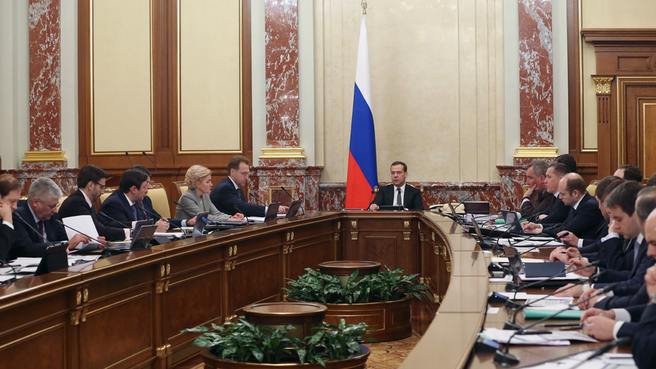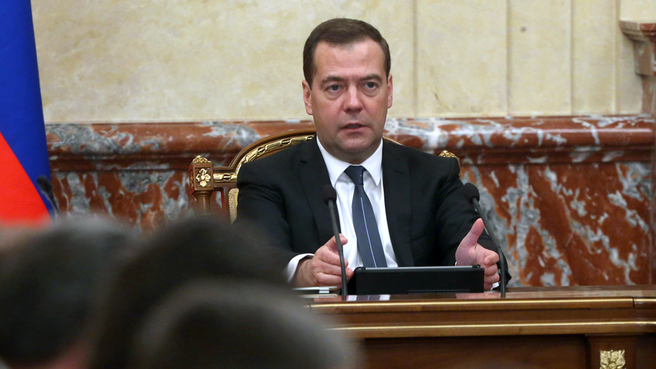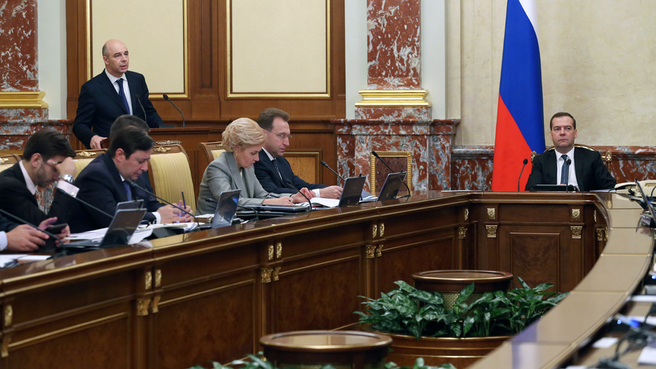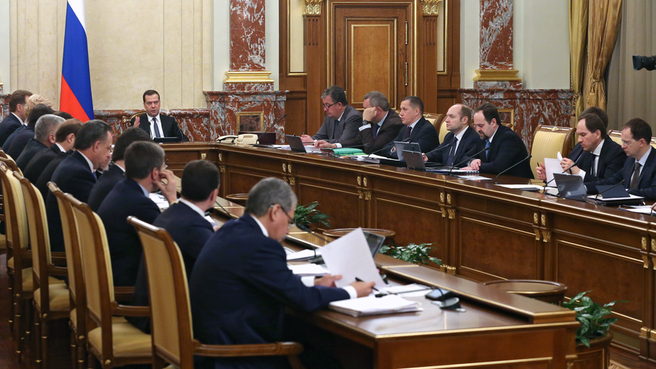Government meeting.
Dmitry Medvedev’s opening remarks
Dmitry Medvedev: We will review proposals related to adjusting the federal budget for 2015 and the 2016-2017 planning period.
When this budget was adopted, the environment was totally different. The budget should correspond to the new economic landscape in which sanctions are exacerbating the sharp change in global prices and slowing growth. The budget should respond to challenges the economy is facing and ensure macroeconomic stability. And, of course, it should be in line with the Government’s plan of priority measures to ensure sustainable economic development, otherwise known as the anti-crisis plan. These are the reasons behind the review of budget spending.
Dmitry Medvedev: "The budget should respond to challenges the economy is facing and ensure macroeconomic stability. And, of course, it should be in line with the Government’s anti-crisis plan."
The main parameters of the reviewed budget were devised with these objectives in mind. Budget revenue is expected to exceed 12 trillion roubles this year, while budget spending would be about 15 trillion roubles with an expected federal budget deficit of 3.8% of GDP.
Changes were made to most spending items. That said, I would like to emphasis right away that social commitments, i.e. the payment of pensions, benefits, subsidies, and compensations, will remain intact. This is a priority for the Government and it must be honoured.
In this challenging environment, it is extremely important to support people, above all, those who are in need of special care from the government, such as families with many children, seniors, and people with disabilities. It is for this reason that we decided not to cut Social Policy spending and even increased it by almost 6 percent.
Pensions have already been adjusted for last year’s inflation effective February 1, 2015. Up to 16 billion roubles will be channelled into providing medicines to beneficiaries of state social assistance, as well as compensating expenses on imported medicines due to changes in the currency exchange rate.
Spending on modernisation of regional preschool education will also be maintained along with state funding aimed at enhancing the competitiveness of the leading universities.
Dmitry Medvedev: "We decided not to cut Social Policy spending and even increased it by almost 6 percent. Pensions have already been adjusted for last year’s inflation effective February 1, 2015. Up to 16 billion roubles will be channelled into providing medicines to beneficiaries of state social assistance."
Amendments to the budget were drafted taking into account measures to support key industries, systematically important enterprises, as well as small and medium-sized businesses.
Spending for these purposes is roughly equal to 2.3 trillion roubles, and allocations will be made available for the main spending items as soon as the first quarter, which is now.
The main objective is to improve the availability of financial resources for those who work in the real economy, to keep incentives in place for business development and the creation of new manufacturing facilities, so that companies are able to take out the loans they need using state guarantees. The volume of state guarantees when taking out loans for project financing will be increased to 60 billion roubles. Investment projects will also benefit from this.
Support is needed for import substitution, which is already becoming apparent in some sectors. Ensuring stability on the labour market is also important. Regions will receive subsidies for paying unemployment benefits.
Dmitry Medvedev: "Amendments to the budget were drafted taking into account measures to support key industries, systematically important enterprises, as well as small and medium-sized businesses. Spending for these purposes is roughly equal to 2.3 trillion roubles."
Additional steps have been devised for balancing regional budgets using budget loans. An additional 160 billion roubles will be set aside to this effect.
Anton Siluanov: Since the budget for 2015-2017 was adopted, the economic environment has changed greatly on the back of external challenges. There is no doubt that the budget policy should change as well.
We have prepared a new forecast, factoring in the reviewed socioeconomic development scenario for 2015, and the new price of oil at 50 dollars per barrel (two times lower than earlier estimates). Economic growth is expected to decelerate by 3%, and the rate of the rouble against the dollar has been adjusted from 37.7 roubles per dollar down to 61.5.
This scenario might seem somewhat conservative, considering that oil is currently traded at 58 dollars per barrel. However, risks remain on the oil market, where there is an excess of supply over demand and oil reserves are rapidly growing. For these reasons, various experts expect the price of oil to be in the range of 40-60 dollars per barrel.
In terms of macroeconomic scenarios, budget revenue projections have been revised down 17.5% from 15.1 trillion roubles to 12.5 trillion. The key factor behind this drop is the re-evaluation of oil and gas revenues. In this sector, revenues are expected to drop by 2 trillion roubles.
The decrease in global oil and gas prices has cost the budget 4.1 trillion roubles in revenue, while the weakening of the rouble has partially offset the decline in revenue, generating 2.3 trillion roubles. Projections for non-oil and gas revenues have been reduced by 596 billion roubles.
Revenue has been on the decline since the very beginning of the first quarter of 2015. In the first two months, it was down 8%, and taking into account non-recurrent factors, this indicator was down 10% in relation to the same period last year. It should be noted that budget proceeds from export duties in January were based on the oil price of 71 dollars per barrel, and the mineral extraction tax at 61 dollars per barrel, while VAT was calculated as of the end of the fourth quarter when revenue was actually quite good. Consequently, in the second quarter we could see a further decline in revenues.
When reviewing budget spending, the following key elements were taken into consideration:
First, the President’s instruction and the decision by the Government to cut federal spending by at least 5% in real terms. Since the annual inflation rate is expected to average 15.8%, budget spending has been capped at 15,215 billion roubles.
This projection includes an adjustment for inflation of some spending items. Pensions have been adjusted based on the actual inflation rate. Spending on some priority areas related to supporting the economy has also been adjusted for inflation. So, on the one hand, we are streamlining expenses, while on the other hand, we had to increase spending by about 500 billion roubles.
In order to achieve the 5% spending cut in real terms, we have reduced spending on state programmes by 10%. Every ministry and agency has worked on streamlining state programmes by fine-tuning various expenditures and evaluating their priority. For that, we will need about 900 billion roubles.
Among other things, such measures include shelving new major construction projects, reducing the number of construction projects carried over from previous years, and passing on adjusting some spending items for inflation that had been factored into earlier budgets. All these efforts have enabled us to reallocate about 1 trillion roubles in federal budget spending.
One
spending cut measure is a 10 percent downsizing of federal state civil servants
and employees in positions other than federal service positions.
At the same time, the budget provides for an array of measures to boost economic growth and bolster economic sectors, including the provision of state guarantees. The volume of state guarantees to support enterprises has been increased by 200 billion roubles. Furthermore, sufficient resources have been provided for the Pension Fund. The total sum will be 283 billion roubles.
Additional budgetary credits of 160 billion roubles have been allocated for the regions to refinance their market obligations that are to be met this year, and measures to support import substitution programmes, the export of goods other than raw materials, and small and medium-sized businesses have also been factored in.
In the first two months of the year, regional budget revenues dropped 7 percent and tax and nontax revenues 10 percent, while spending increased 2 percent. The deficit sat a little over 200 billion roubles. The year-end deficit is expected to be around 600 billion roubles. So, taking into account the need to support the regions, apart from the credits, we have not reduced subsidies in order to even budget sufficiency. In other words, these are the subsidies that are used to meet the regions’ spending obligations. Nor did we reduce the distributed volume of subsidies to balance regional budgets, funds that were to be spent on raising public sector wages.
The next priority is to restore macroeconomic stability. We are proposing a number of steps aimed at easing inflationary pressure on the economy. This involves slower income growth rates. Whereas initially, our growth rates were over 12 percent, now they are below 10 percent.
This also includes measures to reduce spending growth rates such as the non-indexation of wages in the public sector, servicemen and civil servant wages, and limiting indexation of wages and a number of payouts.
Recent statistics in fact show a sharp slowdown of inflation dynamics: In the past week, prices were up just 0.2 percent, which is the minimum level since November.
The implementation of the proposed budgetary policy measures will help strengthen and continue this trend and will give the Bank of Russia greater flexibility in formulating monetary and credit policy, primarily in setting the interest rates on the market today. Therefore the budget is designed to reduce not only inflation, but also interest rates in the economy.
The 2015 budget deficit is expected to be at 2.76 trillion roubles, or 3.8 percent of the GDP. If we hadn’t implemented optimisation measures, the deficit would be 5.2 percent of the GDP.
In these conditions, Reserve Fund resources are becoming the primary source of deficit financing. The spending of 3.17 trillion roubles of the Reserve Fund’s 5 trillion has been proposed. We will also ask parliament to allow us to use up to 500 billion roubles from the Reserve Fund if such a need arises during the execution of the budget.
Such a massive reduction in the Reserve Fund reduces our safety net, which could fall to 2 trillion roubles by the end of the year. Therefore it is necessary to prepare measures to balance the budget for 2016 and 2017 as quickly as possible to achieve the main budget goal – balancing the 2017 budget without a deficit. To this end, we will need to prepare organisational decisions and adopt them during the spring session of parliament.
<…>











